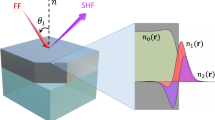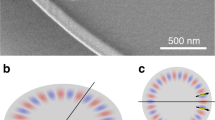Abstract
The orthogonal eigenmodes are well-defined solutions of Hermitian equations describing many physical situations from quantum mechanics to acoustics. However, a large variety of non-Hermitian problems, including gravitational waves close to black holes or leaky electromagnetic cavities, require the use of a bi-orthogonal eigenbasis with consequences challenging our physical understanding1,2,3,4. The need to compensate for energy losses made the few successful attempts5,6,7,8 to experimentally probe non-Hermiticity extremely complicated. We overcome this problem by considering localized plasmonic systems. As the non-Hermiticity in these systems does not stem from temporal invariance breaking but from spatial symmetry breaking, its consequences can be observed more easily. We report on the theoretical and experimental evidence for non-Hermiticity-induced strong coupling between surface plasmon modes of different orders within silver nanodaggers. The symmetry conditions for triggering this counter-intuitive self-hybridization phenomenon are provided. Similar observable effects are expected to exist in any system exhibiting bi-orthogonal eigenmodes.
This is a preview of subscription content, access via your institution
Access options
Access Nature and 54 other Nature Portfolio journals
Get Nature+, our best-value online-access subscription
$29.99 / 30 days
cancel any time
Subscribe to this journal
Receive 12 print issues and online access
$209.00 per year
only $17.42 per issue
Buy this article
- Purchase on Springer Link
- Instant access to full article PDF
Prices may be subject to local taxes which are calculated during checkout



Similar content being viewed by others
References
Bender, C. M., Brody, D. C. & Jones, H. F. Complex extension of quantum mechanics. Phys. Rev. Lett. 89, L391–L394 (2002).
Heiss, W. D. The physics of exceptional points. J. Phys. A 45, 444016 (2012).
Brody, D. C. Biorthogonal quantum mechanics. J. Phys. A 47, 035305 (2014).
Lee, S. Y. Decaying and growing eigenmodes in open quantum systems: biorthogonality and the Petermann factor. Phys. Rev. A 80, 1–9 (2009).
Stehmann, T., Heiss, W. D. & Scholtz, F. G. Observation of exceptional points in electronic circuits. J. Phys. A. 37, 7813–7819 (2004).
Lee, S.-Y. et al. Divergent Petermann factor of interacting resonances in a stadium-shaped microcavity. Phys. Rev. A 78, 015805 (2008).
Doppler, J. et al. Dynamically encircling an exceptional point for asymmetric mode switching. Nature 537, 76–79 (2016).
Shin, Y. et al. Observation of an exceptional point in a two-dimensional ultrasonic cavity of concentric circular shells. Sci. Rep. 6, 38826 (2016).
Leung, P. T., Liu, S. Y. & Young, K. Completeness and orthogonality of quasinormal modes in leaky optical cavities. Phys. Rev. A. 49, 3057–3067 (1994).
Ching, E. S. C. et al. Quasinormal-mode expansion for waves in open systems. Rev. Mod. Phys. 70, 1545–1554 (1998).
Leung, P. T., Suen, W. M., Sun, C. P. & Young, K. Waves in open systems via a biorthogonal basis. Phys. Rev. E 57, 6101–6104 (1998).
Alaeian, H. & Dionne, J. A. Non-Hermitian nanophotonic and plasmonic waveguides. Phys. Rev. B 89, 75136–75139 (2014).
Heiss, W. D. Exceptional points: global and local aspects. AIP Conf. Proc. 597, 311–318 (2001).
Heiss, W. D. Mathematical physics: circling exceptional points. Nat. Phys. 12, 823–824 (2016).
Seyranian, A. P., Kirillov, O. N. & Mailybaev, A. A. Coupling of eigenvalues of complex matrices at diabolic and exceptional points. J. Phys. A. 38, 1723–1740 (2005).
Kodigala, A., Lepetit, T. & Kanté, B. Exceptional points in three-dimensional plasmonic nanostructures. Phys. Rev. B 94, 201103(R) (2016).
Zheng, M. C., Christodoulides, D. N., Fleischmann, R. & Kottos, T. PT optical lattices and universality in beam dynamics. Phys. Rev. A 82, 010103(R) (2010).
Mayergoyz, I. D., Fredkin, D. R. & Zhang, Z. Electrostatic (plasmon) resonances in nanoparticles. Phys. Rev. B 72, 155412 (2005).
Ouyang, F. & Isaacson, M. Surface plasmon excitation of objects with arbitrary shape and dielectric constant. Philos. Mag. B 60, 481–492 (1989).
Yin, X. & Zhang, X. Unidirectional light propagation at exceptional points. Nat. Mater. 12, 175–177 (2013).
Peng, B. et al. Parity time-symmetric whispering-gallery microcavities. Nat. Phys. 10, 394–398 (2014).
Hahn, C. et al. Observation of exceptional points in reconfigurable non-Hermitian vector-field holographic lattices. Nat. Commun. 7, 12201 (2016).
Choi, Y., Hahn, C., Yoon, J., Song, S. H. & Berini, P. Extremely broadband, on-chip optical nonreciprocity enabled by mimicking nonlinear anti-adiabatic quantum jumps near exceptional points. Nat. Commun. 8, 14154 (2017).
García de Abajo, F. & Aizpurua, J. Numerical simulation of electron energy loss near inhomogeneous dielectrics. Phys. Rev. B 56, 15873–15884 (1997).
Hohenester, U. & Trügler, A. MNPBEM – A Matlab toolbox for the simulation of plasmonic nanoparticles. Comput. Phys. Commun. 183, 370–381 (2012).
Boudarham, G. & Kociak, M. Modal decompositions of the local electromagnetic density of states and spatially resolved electron energy loss probability in terms of geometric modes. Phys. Rev. B 85, 245447 (2012).
Fredkin, D. R. & Mayergoyz, I. D. Resonant behavior of dielectric objects (electrostatic resonances). Phys. Rev. Lett. 91, 253902 (2003).
Schmidt, F.-P. et al. Edge mode coupling within a plasmonic nanoparticle. Nano. Lett. 16, 5152–5155 (2016).
Das, P., Lourenço-Martins H., Tizei, H. G. L., Weil, R. & Kociak, M. Nanocross: a highly tunable plasmonic system. J. Phys. Chem. C 121, 16521–16527 (2017).
Trügler, A., Tinguely, J.-C., Krenn, J. R., Hohenau, A. & Hohenester, U. Influence of surface roughness on the optical properties of plasmonic nanoparticles. Phys. Rev. B 83, 81412 (2011).
Schmidt, F.-P., Ditlbacher, H., Hofer, F., Krenn, J. R. & Hohenester, U. Morphing a plasmonic nanodisk into a nanotriangle. Nano. Lett. 14, 4810–4815 (2014).
Zener, C. Non-adiabatic crossing of energy levels. Proc. Royal Soc. A 137, 696–702 (1932).
Brown, L. V., Sobhani, H., Lassiter, J. B., Nordlander, P. & Halas, N. J. Heterodimers: plasmonic properties of mismatched nanoparticle pairs. ACS Nano 4, 819–832 (2010).
Novotny, L. Strong coupling, energy splitting, and level crossings: a classical perspective. Am. J. Phys. 78, 1199–1202 (2010).
Collins, S. M., Nicoletti, O., Rossouw, D., Ostasevicius, T. & Midgley, P. A. Excitation dependent Fano-like interference effects in plasmonic silver nanorods. Phys. Rev. B 90, 155419 (2014).
Nordlander, P., Oubre, C., Prodan, E., Li, K. & Stockman, M. I. Plasmon hybridization in nanoparticle dimers. Nano. Lett. 4, 899–903 (2004).
Nelayah, J. et al. Mapping surface plasmons on a single metallic nanoparticle. Nat. Phys. 3, 348–353 (2007).
Bender, C. M. & Boettcher, S. Real spectra in non-hermitian hamiltonians having PT-symmetry. Phys. Rev. Lett. 80, 5243–5246 (1998).
Guo, A. et al. Observation of PT-symmetry breaking in complex optical potentials. Phys. Rev. Lett. 103, 093902 (2009).
Rüter, C. E. et al. Observation of parity–time symmetry in optics. Nat. Phys. 6, 192–195 (2010).
Alaeian, H. & Dionne, J. A. Parity-time symmetric plasmonic metamaterials. Phys. Rev. A. 89, 033829 (2014).
Musslimani, Z. H., Makris, K. G., El-Ganainy, R. & Christodoulides, D. N. Optical solitons in PT periodic potentials. Phys. Rev. Lett. 100, 030402 (2008).
Makris, K. G., El-Ganainy, R., Christodoulides, D. N. & Musslimani, Z. H. Beam dynamics in PT symmetric optical lattices. Phys. Rev. Lett. 100, 103904 (2008).
Gloter, A., Douiri, A., Tence, M. & Colliex, C. Improving energy resolution of EELS spectra: an alternative to the monochromator solution. Ultramicroscopy 96, 385–400 (2003).
Acknowledgements
We thank O. Stéphan and M. Walls for in-depth reading of the manuscript. This work has received support from the French state managed by the National Agency for Research under the programme of future investment EQUIPEX TEMPOS-CHROMATEM with the reference ANR-10-EQPX-50.
Author information
Authors and Affiliations
Contributions
P.D., H.L.-M. and M.K. designed the experiments. H.L.-M., P.D., L.H.G.T. and M.K. performed the EELS experiments. R.W., P.D. and H.L.-M. prepared the samples. H.L.-M., P.D. and L.H.G.T. analysed the data. H.L.-M. and M.K. performed the theoretical analysis. H.L.-M. performed simulations. H.L.-M. and M.K. wrote the manuscript. H.L.-M., P.D., L.H.G.T. and M.K. discussed experimental and theoretical results, and participated in improvement of the manuscript.
Corresponding author
Ethics declarations
Competing interests
The authors declare no competing financial interests.
Additional information
Publisher’s note: Springer Nature remains neutral with regard to jurisdictional claims in published maps and institutional affiliations.
Supplementary information
Supplementary Information
1. Physical Origin of Plasmonic Bi-Orthogonality, 2. LSP versus Electromagnetic Wave in Open Systems, 3. Phase Diagram, 4. Coupling Constant, 5. The Overlap Matrices, 6. Determination of the F-Symmetric Geometrical Configurations, 7. Experimental.
Rights and permissions
About this article
Cite this article
Lourenço-Martins, H., Das, P., Tizei, L.H.G. et al. Self-hybridization within non-Hermitian localized plasmonic systems. Nature Phys 14, 360–364 (2018). https://doi.org/10.1038/s41567-017-0023-6
Received:
Accepted:
Published:
Issue Date:
DOI: https://doi.org/10.1038/s41567-017-0023-6
This article is cited by
-
Plasmonic and thermoplasmonic properties of asymmetric hexagonal nano-ring dimer
Optical and Quantum Electronics (2022)
-
Symmetry-breaking-induced plasmonic exceptional points and nanoscale sensing
Nature Physics (2020)
-
Selectively exciting quasi-normal modes in open disordered systems
Nature Communications (2018)



